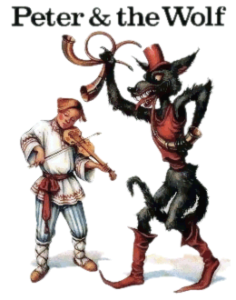Prokofiev, Peter and the Wolf
Several times in the course of writing this series (four years now) I have taken up a topic that I stick with for a few weeks, although I try to be sure each week’s entry can stand alone.
Last week we looked at Robert Schumann’s Scenes from Childhood, which, as we noted, was written more for adults than children. But because many of our readers are actively engaged in raising and educating children, I think we should take a look at some works specifically intended for children. I won’t do them all in immediate succession, but have a few in mind for the next couple of months.
Children learn many simple childhood songs: “Old MacDonald,” “Wheels on the Bus,” etc. The simplicity of those songs generally doesn’t resonate with adults. The typical “classical” work for children is not based on that kind of musical simplicity. I believe children can take in many serious classical works. But the works we want to consider have clarity of form and vivid imagery—things that bolster the child’s experience—while retaining sophisticated musical content that make the works enjoyable for adults as well.
And, of course, tying the music concretely to a story seems to be the best formula for success.

Much of Prokofiev’s music, with its clarity and vivid imagery, will appeal to children: the ballet Romeo and Juliet, the march from The Love of Three Oranges, and the famous “Troika” from Lieutenant Kije, and others. But Peter and the Wolf has to be the granddaddy of them all.
The work was composed in 1936, the year Prokofiev resettled in Soviet Russia after having emigrated to the West in 1918. He had been commissioned to write a children’s work that would introduce instruments of the orchestra and also promote Bolshevik virtues. But the virtues of the story owe nothing to the Bolsheviks, and the tale resonates in any culture. It is Prokofiev’s most recorded work.



